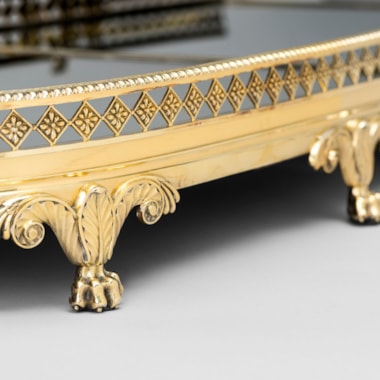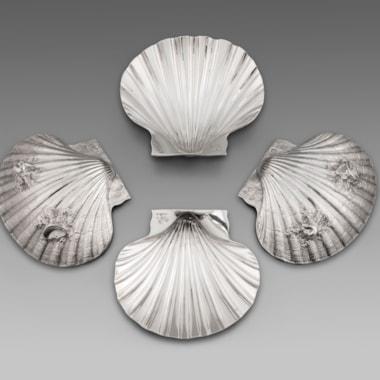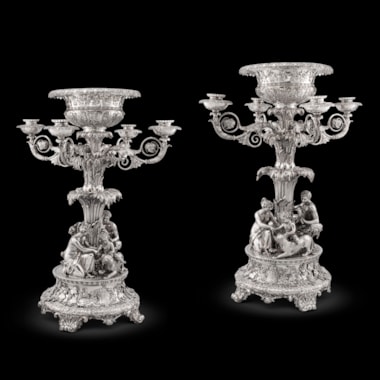Tapering cylindrical and on four foliage engraved scroll feet, applied at the rim with foliage scroll strapwork on a textured ground and with two cartouches, each engraved with the Royal coat-of-arms, with two foliage cast and chased handles, applied with the Royal supporters, the detachable cover applied with strapwork and with a finial cast as the Royal crest and crown, engraved underneath with an inscription, with a Victorian Irish silver liner, marked underneath with maker's mark only four times and on liner.
The inscription reads ‘Lady Emilia Lenos Oct. 25th 1731’
The elaborate nature of Emilia Lennox's Royal christening cup, with is heraldic ornament, sets it apart from other Royal christening gifts of the period. It was customary for the King to give his god-children a piece of plate of their christening, however, this usually took the form of a plainer cup and cover, the usual form being two-handled and with a spool shaped cover, sometimes accompanied by a stand or tazza. These were similar to larger cups and covers also provided by the Jewel House, but for use of Ambassadors as part of their Perquisite of Plate. One such cup was that given by King George I to George Townshend, later 4th Viscount and 1st Marquess Townshend (1724-1807), see The Townshend Heirlooms, sold by order of the Marquis [sic] Townshend; Christie's London, 3 March 1904, lot 44.
I would seem likely from the wording of the warrant sent to the Keeper of the Jewel House that it was the Duke who ensured the design was as grand as possible, the Royal nature of the gift very visible through the use of the Royal supporters as handles and the Royal crest forming the finial. The warrant (PRO MSS. LC5/105, folio 532) addressed to Lord Lynn, Master of the Jewel House, reads 'These [letters] are to signify unto your Lordship His Maj'ties Pleasure that you provide and deliver to his Grace the Duke of Richmond the quantity of Two Hundred Ounces of gilt plate as a gift from his Majesty at the Christening of his Child to be made into such vessels and after such fashion as his Grace shall direct And for so doing this shall be your Lordships Warrant Given under my hand this 2d day of Dec'r. 1731 In the fifth year of His Majesties Reign.' Lady Emilia had been christened just over one month previously at St. Margaret's Church, Westminster as shown by entry in the parish register dated 31 October. Her other godparents were Princess Emelia, presumably Princess Amelia (1711-1786), second daughter of King George II, and Camilla, Countess of Tankerville (1697-1775). Emilia was a distant cousin of the king, her father being the grandson of King Charles II by his mistress Louise de Ke<\sup>roualle, Duchess of Portsmouth (1649-1734). Charles, 2nd Duke of Richmond served as aide-de-camp to both King George I and King George II. On the accession of King George II he was appointed Lord High Constable of England and Lord of the Bedchamber. He and his wife Anne (d.1722) had twelve children, a number their daughter Emilia well exceeding bearing nineteen children ten of whom lived into adulthood.
Lady Emilia's marriage to the ambitious Irish aristocrat James, 20th Earl of Kildare was at first opposed by her parents, their preference being an Englishman, however they overcame their reservations and the wedding was the talk of society. The rumour that she received not a penny of a dowry was malicious gossip as it is recorded that she received the same sum as her younger sisters.
King George II's christening gift to his goddaughter Lady Emilia Lennox (1731-1814), daughter of Charles, 2nd Duke of Richmond and Lennox (1701-1750), later wife of James, 20th Earl of Kildare, created 1st Duke of Leinster and then by descent to
Gerald, 8th Duke of Leinster (1914-2004)
His Grace the Duke of Leinster; Sotheby's, London, 3 May 1984, lot 75.
The Glory of the Goldsmith, Magnificent Gold and Silver from the Al-Tajir Collection, 1989, p. 96.
You May Also Like








































































